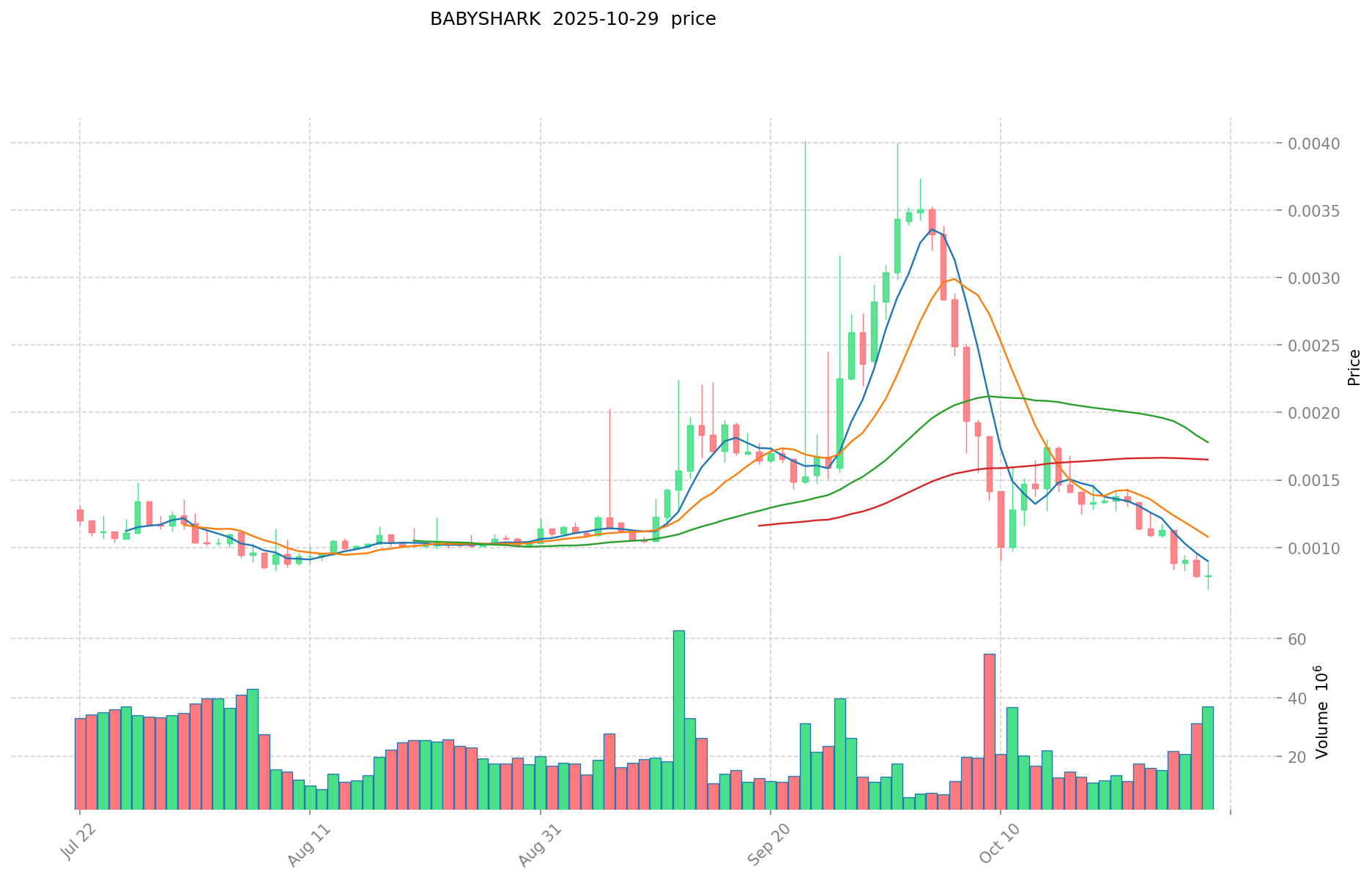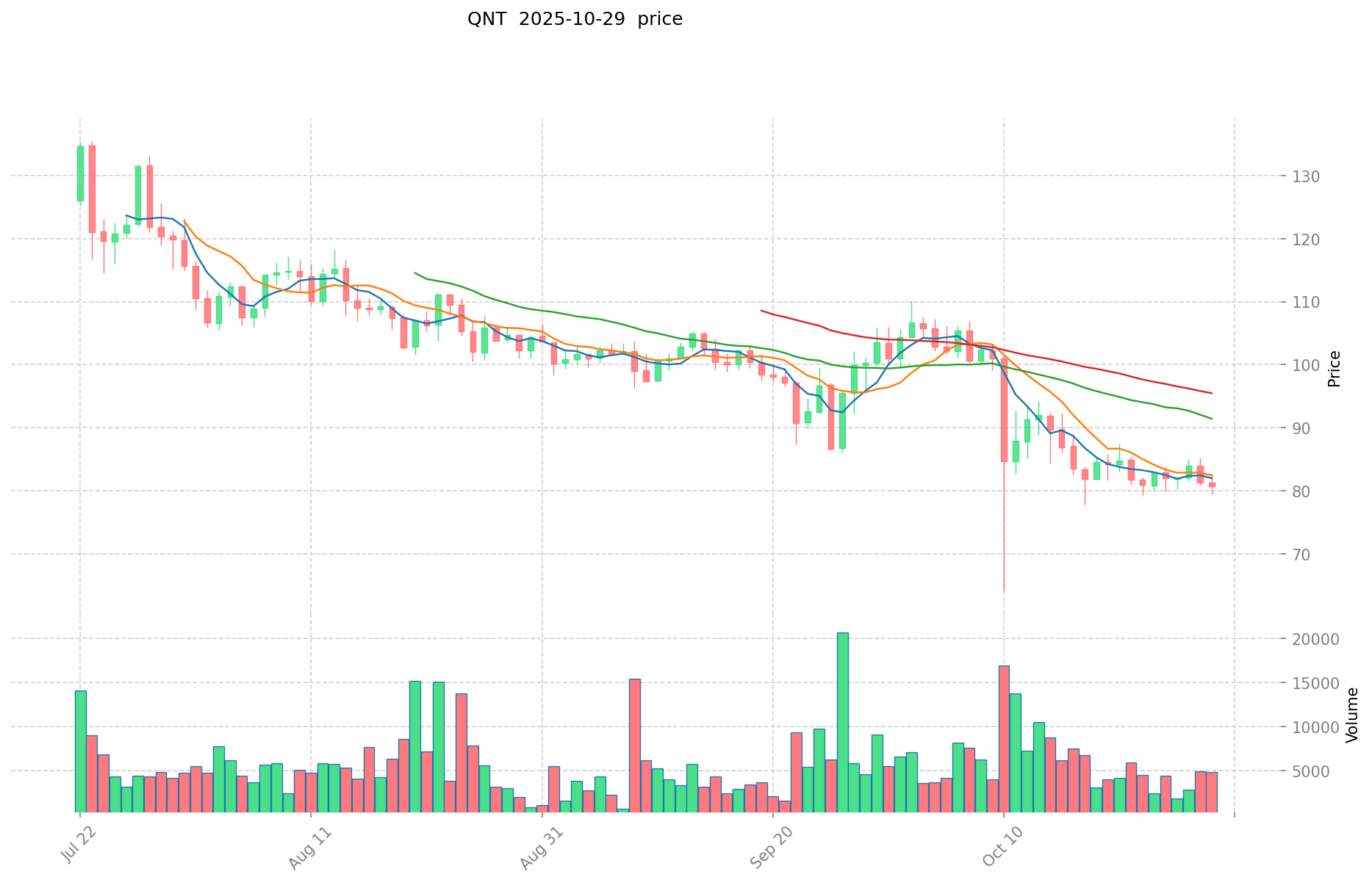BABYSHARK vs QNT: The Clash of Crypto Titans in the DeFi Ocean
Introduction: Investment Comparison of BABYSHARK vs QNT
In the cryptocurrency market, the comparison between BABYSHARK vs QNT has been an unavoidable topic for investors. The two not only differ significantly in market cap ranking, application scenarios, and price performance, but also represent different cryptocurrency asset positioning.
BABYSHARK (BABYSHARK): Since its launch, it has gained market recognition for its fun and inclusive Web3 experience.
QNT (QNT): Since its inception in 2018, it has been hailed as a solution for blockchain interoperability, becoming one of the leading cryptocurrencies in enterprise innovation and blockchain adoption.
This article will comprehensively analyze the investment value comparison between BABYSHARK vs QNT, focusing on historical price trends, supply mechanisms, institutional adoption, technological ecosystems, and future predictions, attempting to answer the question investors care about most:
"Which is the better buy right now?"
I. Price History Comparison and Current Market Status
BABYSHARK (Coin A) and QNT (Coin B) Historical Price Trends
- 2025: BABYSHARK reached an all-time high of $0.0393, followed by a significant price decline.
- 2021: QNT hit its all-time high of $427.42 on September 11, 2021, during a broader crypto market rally.
- Comparative analysis: In the current market cycle, BABYSHARK has dropped from its high of $0.0393 to $0.0009643, while QNT has declined from $427.42 to around $80.27.
Current Market Situation (2025-10-29)
- BABYSHARK current price: $0.0009643
- QNT current price: $80.27
- 24-hour trading volume: BABYSHARK $36,251.79 vs QNT $417,364.57
- Market sentiment index (Fear & Greed Index): 51 (Neutral)
Click to view real-time prices:
- View BABYSHARK current price Market Price
- View QNT current price Market Price


II. Core Factors Influencing BABYSHARK vs QNT Investment Value
Supply Mechanisms Comparison (Tokenomics)
- BABYSHARK: Supply mechanism determined by market demand
- QNT: Supply influenced by market sentiment and macroeconomic policies
- 📌 Historical Pattern: Supply mechanisms drive price cycles through supply-demand relationships and market dynamics.
Institutional Adoption and Market Applications
- Institutional Holdings: Adoption levels influenced by market dynamics
- Enterprise Adoption: Applications in cross-border payments, settlements, and investment portfolios vary based on market conditions
- National Policies: Regulatory attitudes vary and impact investment value
Technical Development and Ecosystem Building
- Technical developments for both tokens influenced by market sentiment
- Ecosystem Comparison: Implementation in DeFi, NFT, payments, and smart contracts dependent on market dynamics
Macroeconomic Factors and Market Cycles
- Inflation Performance: Anti-inflationary properties determined by supply-demand dynamics
- Macroeconomic Monetary Policy: Interest rates and dollar index influence both tokens
- Geopolitical Factors: Cross-border transaction demands and international situations affect value
III. 2025-2030 Price Prediction: BABYSHARK vs QNT
Short-term Prediction (2025)
- BABYSHARK: Conservative $0.000774522 - $0.0009562 | Optimistic $0.0009562 - $0.001070944
- QNT: Conservative $41.86 - $80.5 | Optimistic $80.5 - $119.945
Mid-term Prediction (2027)
- BABYSHARK may enter a growth phase, with estimated prices ranging from $0.000764233288 to $0.0015754963168
- QNT may enter a bullish market, with estimated prices ranging from $65.600637375 to $160.90722375
- Key drivers: Institutional capital inflow, ETF, ecosystem development
Long-term Prediction (2030)
- BABYSHARK: Base scenario $0.001857568356811 - $0.002600595699535 | Optimistic scenario $0.002600595699535
- QNT: Base scenario $150.2693996383125 - $210.3771594936375 | Optimistic scenario $210.3771594936375
Disclaimer: This analysis is for informational purposes only and should not be considered as financial advice. Cryptocurrency markets are highly volatile and unpredictable. Always conduct your own research before making any investment decisions.
BABYSHARK:
| 年份 | 预测最高价 | 预测平均价格 | 预测最低价 | 涨跌幅 |
|---|---|---|---|---|
| 2025 | 0.001070944 | 0.0009562 | 0.000774522 | 0 |
| 2026 | 0.00133791504 | 0.001013572 | 0.00097302912 | 5 |
| 2027 | 0.0015754963168 | 0.00117574352 | 0.000764233288 | 21 |
| 2028 | 0.001912111686576 | 0.0013756199184 | 0.001059227337168 | 42 |
| 2029 | 0.002071270911134 | 0.001643865802488 | 0.001052074113592 | 70 |
| 2030 | 0.002600595699535 | 0.001857568356811 | 0.001578933103289 | 92 |
QNT:
| 年份 | 预测最高价 | 预测平均价格 | 预测最低价 | 涨跌幅 |
|---|---|---|---|---|
| 2025 | 119.945 | 80.5 | 41.86 | 0 |
| 2026 | 147.327075 | 100.2225 | 59.131275 | 24 |
| 2027 | 160.90722375 | 123.7747875 | 65.600637375 | 54 |
| 2028 | 152.30487601875 | 142.341005625 | 81.13437320625 | 77 |
| 2029 | 153.21585845475 | 147.322940821875 | 75.13469981915625 | 83 |
| 2030 | 210.3771594936375 | 150.2693996383125 | 76.637393815539375 | 87 |
IV. Investment Strategy Comparison: BABYSHARK vs QNT
Long-term vs Short-term Investment Strategies
- BABYSHARK: Suitable for investors focused on Web3 experiences and community-driven projects
- QNT: Suitable for investors looking for enterprise blockchain solutions and interoperability
Risk Management and Asset Allocation
- Conservative investors: BABYSHARK: 5% vs QNT: 15%
- Aggressive investors: BABYSHARK: 15% vs QNT: 30%
- Hedging tools: Stablecoin allocation, options, cross-currency portfolios
V. Potential Risk Comparison
Market Risk
- BABYSHARK: High volatility due to meme coin status
- QNT: Susceptible to overall crypto market trends
Technical Risk
- BABYSHARK: Scalability, network stability
- QNT: Security vulnerabilities, potential interoperability issues
Regulatory Risk
- Global regulatory policies may impact both tokens differently, with potential stricter oversight on meme coins
VI. Conclusion: Which Is the Better Buy?
📌 Investment Value Summary:
- BABYSHARK advantages: Strong community engagement, potential for viral growth
- QNT advantages: Enterprise adoption, focus on interoperability solutions
✅ Investment Advice:
- New investors: Consider a small allocation to BABYSHARK for exposure to community-driven projects, larger allocation to QNT for more established technology
- Experienced investors: Balanced approach between BABYSHARK and QNT based on risk tolerance
- Institutional investors: Focus on QNT for its enterprise solutions and potential for widespread adoption
⚠️ Risk Warning: The cryptocurrency market is highly volatile. This article does not constitute investment advice. None
VII. FAQ
Q1: What are the main differences between BABYSHARK and QNT? A: BABYSHARK is a meme coin focused on fun Web3 experiences, while QNT is designed for enterprise blockchain interoperability. BABYSHARK has higher volatility and community engagement, whereas QNT offers more established technology and potential for widespread adoption.
Q2: Which token has performed better historically? A: QNT has shown stronger historical performance, reaching an all-time high of $427.42 in September 2021. BABYSHARK's all-time high was $0.0393, but it has experienced significant price decline since then.
Q3: How do the supply mechanisms differ between BABYSHARK and QNT? A: BABYSHARK's supply mechanism is primarily determined by market demand, while QNT's supply is influenced by market sentiment and macroeconomic policies.
Q4: What are the price predictions for BABYSHARK and QNT by 2030? A: By 2030, BABYSHARK is predicted to reach between $0.001857568356811 and $0.002600595699535, while QNT is expected to be between $150.2693996383125 and $210.3771594936375 in the base scenario.
Q5: How should investors allocate their portfolio between BABYSHARK and QNT? A: Conservative investors might consider allocating 5% to BABYSHARK and 15% to QNT, while aggressive investors could allocate 15% to BABYSHARK and 30% to QNT. However, these allocations should be adjusted based on individual risk tolerance and investment goals.
Q6: What are the main risks associated with investing in BABYSHARK and QNT? A: BABYSHARK faces high volatility due to its meme coin status and potential technical risks. QNT is susceptible to overall crypto market trends and potential interoperability issues. Both tokens may be impacted by regulatory risks, with meme coins potentially facing stricter oversight.
Q7: Which token is better suited for institutional investors? A: QNT is generally considered more suitable for institutional investors due to its focus on enterprise blockchain solutions and interoperability, which align better with institutional needs and risk profiles.
Share
Content